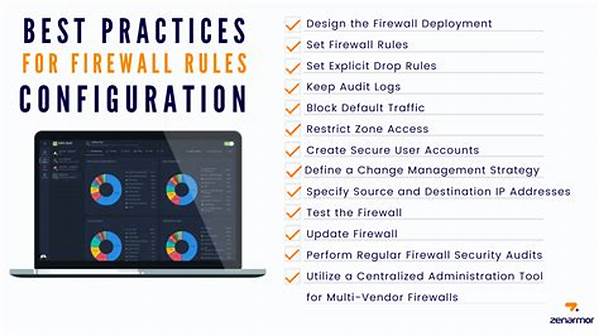Hey there, tech enthusiasts! If you’re venturing into the world of cybersecurity, one of the first things you’ll need to get friendly with is firewall configuration. Now, that might sound as exciting as watching paint dry, but trust me, setting up your firewall correctly is like having an invincible shield around your network. So, let’s dive into the essentials of firewall configuration best practices and make sure your digital fortress is rock solid!
Understanding Firewall Essentials
Before we dive any deeper, let’s get cozy with the basics of firewall configuration best practices. Think of your firewall as a digital bouncer at a club. Its job? Let the good traffic in and keep the sketchy stuff out. Pretty neat, huh? A well-configured firewall can make or break your network security. So, what are some fundamental best practices to keep in mind?
First off, you need to customize your firewall settings according to your specific needs rather than sticking to default settings. Defaults might be convenient, but they’re also what hackers expect. Secondly, make sure you’re keeping a keen eye on your firewall logs. They’re like a journal for your firewall, letting you know what it’s been up to and if anything fishy is going on. Last but not least, regularly review and update your firewall rules. Just like any rulebook, things need to evolve over time to keep pace with new threats.
Five Crucial Tips for Firewall Setup
1. Keep it Updated: Regular updates ensure your firewall is armored against the latest threats. Falling behind on updates? That’s not the kind of thrill you need.
2. Segment Your Network: Divide and manage parts of your network separately. It’s like having multiple security checkpoints.
3. Implement Strong Outbound Rules: Don’t just focus on inbound traffic. Knowing and controlling what’s going out is equally vital.
4. Regular Audits: Schedule routine check-ups for your firewall settings. Think of it like a health check, but for your network.
5. Educate Your Team: Keeping your team informed about firewall configuration best practices ensures no one accidentally creates security hazards.
Advanced Tactics for Firewall Management
Now, once you’ve got the basics down pat, it’s time to elevate your game with some advanced firewall configuration best practices. Picture this: You’ve got your customized rules, regular updates, and keen monitoring on lock. What’s next? Enter intrusion prevention systems (IPS) and detection systems (IDS). Integrating these with your firewall can act as a double-layered security net.
Moreover, don’t shy away from leveraging AI and machine learning. These tech wonders can analyze traffic patterns and detect anomalies faster than any human ever could. And remember, as you delve deeper into complexity, proper documentation becomes crucial. Keep a detailed diary of every rule and setting adjustment for future reference. This way, when you or anyone else needs to troubleshoot, it’s more like a pleasant stroll in the park than a frantic treasure hunt.
Essential Elements of Firewall Rule Setting
1. Restrict Administrative Access: Limit who can tweak firewall settings for tighter control and better security.
2. Utilize VPNs: Secure remote access by enforcing VPN use. It’s like a secret passageway that’s just for your trusted allies.
3. Specialize Rules for Each Zone: Ensure each network zone is protected by rules tailored to its specific needs.
4. Deny by Default: Start with a deny-all rule, opening up only what is necessary. It’s a minimalist’s dream approach to security.
5. Monitor Changes: Any alteration in firewall configurations should be logged and reviewed.
6. Stay Compliant: Align your firewall configurations with industry standards and compliance requirements. It’s not just good sense; it’s mandatory.
7. Trust No One: Adopt a zero-trust policy within your network for ultimate hardcore defense.
8. Simulate Attacks: Regularly test your firewall’s defenses by simulating cyberattacks.
9. Backup Configurations: Always have a backup of your firewall settings, ready to restore peace after a crisis.
10. Utilize Application-Aware Features: Fine-tune access control using application firewall features.
Continuous Firewall Monitoring Strategies
Consistent vigilance is key to maintaining the effectiveness of your firewall configuration best practices. You might have the sharpest firewall setup, but threats evolve – and so should your observance. Real-time attack visualization tools can aid your team in understanding potential threats as they happen, offering the insight needed to respond swiftly.
Network traffic analysis should be your best buddy, enabling you to catch anomalies and weird patterns before they unfold into full-blown threats. Consider automated alert systems as well. There’s elegance in being notified the moment something goes awry without having to hunch over your monitor incessantly. Amidst all this, don’t neglect post-incident reviews that offer learnings for beefing up your fortifications even more robustly.
The Human Element in Firewall Management
While we can talk all day about tools and techniques, let’s not forget the human touch in firewall configuration best practices. Your IT team is the brains behind this operation, and empowering them with the right knowledge and resources is crucial. Regular training sessions can hone their skills and keep them at the top of this rapidly evolving field.
Similarly, fostering an environment where open communication about cybersecurity concerns is encouraged can lead to proactive problem-solving. Encourage team members to share their insights or any ominous signs they’ve noticed. Cultivating this kind of awareness throughout your organization can substantially bolster your defense strategies.
Summing Up the Firewall Best Practices
Alright, time to wrap this up, folks. Adhering to firewall configuration best practices may seem like a Herculean task at first, but by breaking it down into manageable steps, it becomes gracefully approachable. From understanding the essentials and delving into advanced tactics, all the way to the crucial human element, each part plays a pivotal role in fortifying your digital defenses.
Remember, cybersecurity isn’t just about setting and forgetting. It’s a living, breathing effort that requires constant nurturing and improvement. So, don your digital armor, rally your team, and step confidently into the virtual world, knowing you’re well-equipped to tackle the unseen threats lurking in cyberspace. Until next time, happy configuring!

